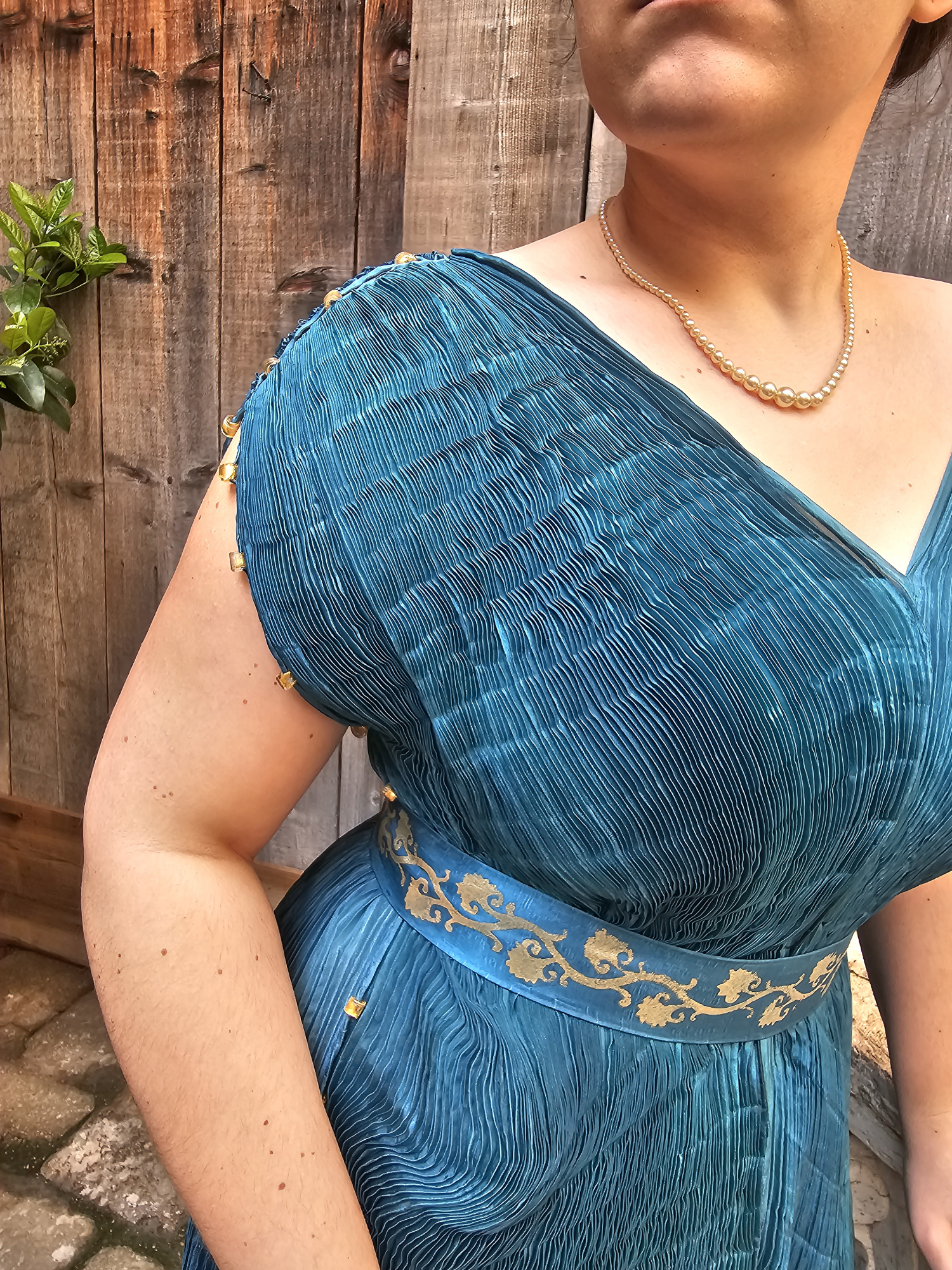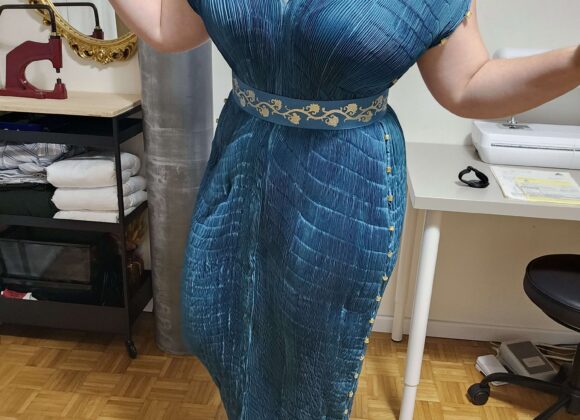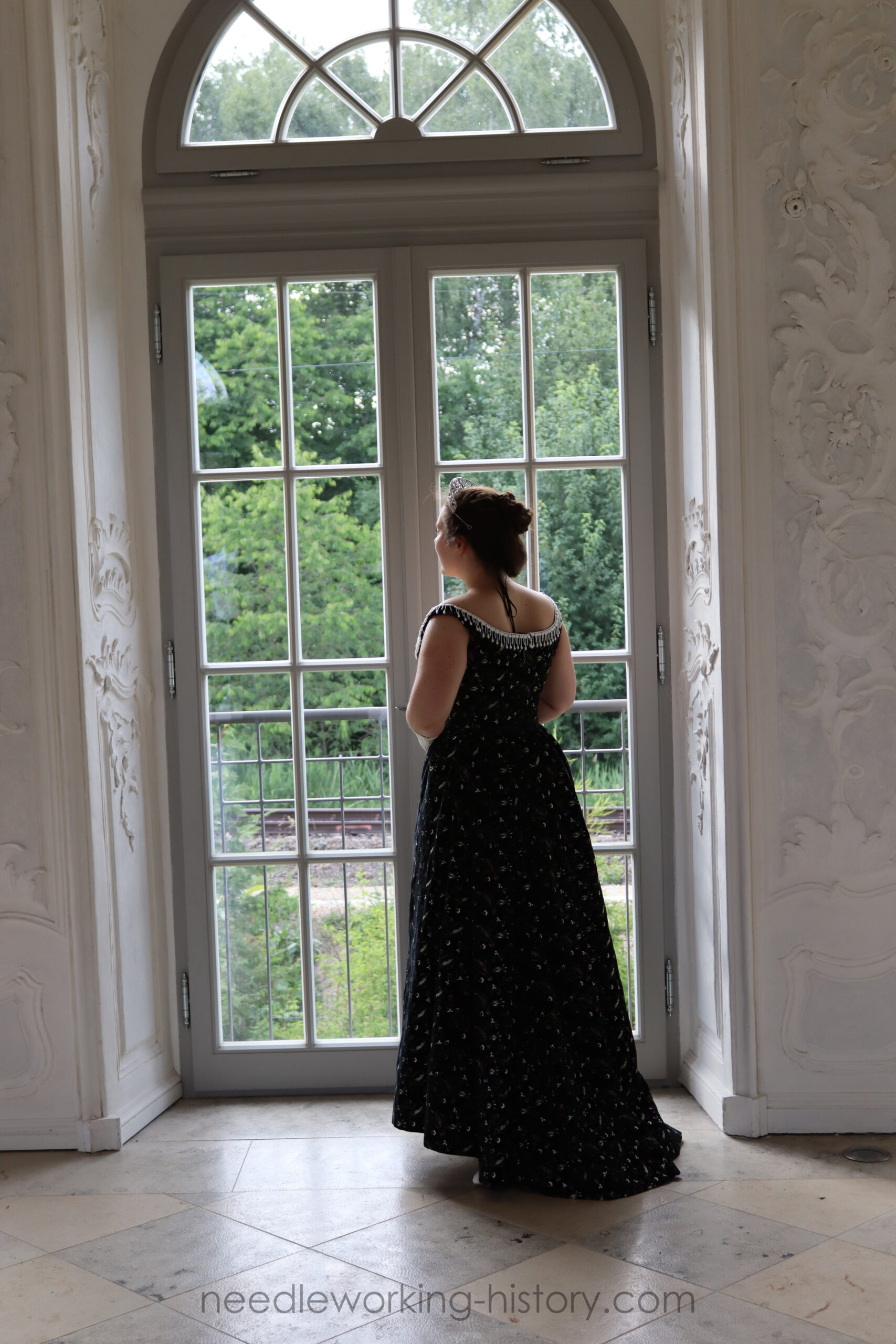Mariano Fortuny and the Delphos dress
Mariano Fortuny was spanish but nowadays he’s most known for the time when he lived in venice in italy. He was an artist, architect and inventor and not, like many sources say, a fashion designer. He did not see the dresses as fashion, but more as a form of textile art.
In the world of theatre he is known for his invention of indirect stage lighting!
But in our cirle of fashion (history) enthusiasts he is widly known for the Delphos dress. But the dress wasn’t his invention alone. His future wife Henriette Negrin helped creating the delphos gowns and is even credited in the patent registration.
The dress itself was based on dresses from ancient greece and it is said that the Delphos is based on the sculpture ‚Charioteer of Delphi‘ which was found in 1896 in Delphi.

Invented in 1905 and filed for patent application in 1909 the Delphos was an absolute sensation. As you probably know at the beginning of the 20th century women wore the fashionable S-silhouette. Sans-ventre corsets, padded chests and behinds to get the pidgeon breast and more curves, paired with huge hats, feathers, lace and so much decoration.
Quite the contrary was the Delphos. A tightly pleated dress, loosley falling from the shoulders, surrounding the nature-given curves of the wearer, maybe cinched at the waist with a beautifully stenciled belt. At first the dress was used to wear around your home, overlong to hide the naked feet but it became popular quite fast and became a dress for everyday wear of very fashion forward women.
And the dress was worn without the typical underwear of the time. So no corsets, no chemisettes and no padding. I couldn’t find information if the dresses were worn with a chemise underneath, but I think they were worn to protect the garment a little bit.
As time progressed the dress was adapted. Sleeveles, with a Peplos, floor length, different necklines and I even found a picture of ‚Fortuny pants‚.



But not only the shape of the dress was special, also the making of the dress was different to other dresses. Super tight pleats with a depth of 2-6mm made with super fine silks from japan, weighed down with Murano glass beads because the dresses were so light in weight. It’s also interesting that those dresses were not hung but stored in fancy little boxes, twisted into a knot so that the pleats hold the shape longer. When the dress was soiled or stained you did send them back to Fortuny in Venice where they got cleaned and repleated.
Those dresses still remain a big mystery because Fortuny and Negrin never shared how the dresses really were made.
I would like to recommend this Arts and Culture post to learn more about Fortuny and see how a dress decoils. It’s absolutley breathtaking.
The Making of my Fauxtuny
The exact production of the dress is and remains a well-kept secret. The secret of permanent pleating was taken to the grave by Fortuny’s wife, but a few years ago, thanks to much research, the secret was probably revealed. Or at least the House of Fortuny claims to know the secret. Sadly they don’t make the Fortuny gowns in the old way. The new ones which are exclusively sold in Venice, Paris and Munich are made from polyester and to be honest not very pretty. They are way too regular to have the charm of the old Fortuny gown and even though polyester holds the shape and does not need repleating…it’s just not the same.
Unfortunately, they don’t reveal the secret behind these extremely tight and small pleats and I made it my mission to get at least somewhat close to the original pleats.
Through the search skills of a friend and Google translate, I’ve already found out a lot of exciting info in a japanese paper. Sadly I cannot find the link anymore, but if I find it, I’ll add it to this post.
I also found a few people online who have already tried to copy Fortuny dresses, including Grimilde Malatesta, who gave me the tip to contact @missvioletvixen, who owns real Fortuny dresses herself. She was absolutely charming, gave me tips, solved a few of my questions and also said I can keep pestering her anytime.
Materials and costs
At first I thought that this project will be a fast, simple and cheap project but in the end it was one of the most expensive dresses I’ve ever made. Only my Marie Antoinette gown was more expensive. It’s absolutley possible to make it a LOT cheaper with buying readymade glass beads, but I wanted them exactly as I got them.
I decided to order a silk habotai with 6 momme. This corresponds to a weight of about 26 grams per square metre. I dyed the fabric using Javana batik textile dye from Kreul. I also did a colour test with Simplicol Expert in the colour navy blue, but was very disappointed. It was not a pretty blue and had weird spots all over it.
For the silk ribbons onto which the Murano glass beads will be threaded, I used a silk habotai ribbon. I had my beads made to my specifications by Karin Freitag of Flammenzauberei. She used Murano glass rods and real gold leaf. Actually, I wanted to get the beads directly from Venice, but the local dealers and producers either didn’t answer me or couldn’t make the beads the way I wanted them. So I decided to shop local.
That was it for now. In the next post I will show you how my pleating tests went and how I actually made my Fortuny gown!
| 7 m Habotai silk | € 64,71 |
| 1 package Kreul Dye | € 4,95 |
| 2 balls crochet yarn | € 2,- |
| 10 m Habotai Foulard Cord | € 16,84 |
| 100 Murano beads with real gold leaf | € 185,- |
| vinegar | € 1,59 |
| Extras | € 5,- |
| Total costs | € 280,09 |



